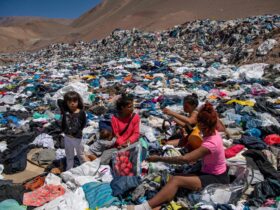The Dark Side of Solar Panels?

It is no secret solar panels have been on the rise in the last decade. You might have seen them on the news, cropping up on your neighbors’ houses, or even succumbed to peer pressure (or the desire to save the planet) and installed some yourself.
This is a good thing, right? To reduce our production of polluting fossil fuel emissions? Yes and no. Yes, less greenhouse gas emissions mean a more sustainable future. However, we should not run blindly into this transition without being aware of some of the negative impacts of this energy source.
Solar panels, like everything else, rely on the global supply chain. This means there are considerations at every step along the way, from the mining of materials to the manufacturing and endlife of panels. However, while there are problems at each step, how do they compare to the negative impacts of natural gas, which is often considered the “cleanest” fossil fuel? How do the supply chains of these two sources compare?
Mining and Fracking
The first step to building a solar panel is extracting the necessary elements from the earth via mining. Mining unearths toxic materials and is often carried out near residential or urban environments; as such, raw material mining can lead to human safety concerns. Workers face risks of failing heavy machinery or long-term disease risks, and mining activities can also affect surrounding communities through air and water pollution. An example of this is Cerro de Pasco, Peru, where nearby water sources had 3,200x more cadmium, 6,000x more iron, 200x more manganese and 197x more zinc than national legal limits. Lead, arsenic and mercury are also found in the water. These pollutants cause cancers, kidney damage, infertility and neurological diseases. Lead has damaged brain development, social abilities and language and motor skills in children; the average IQ for children in this town is 12.3 points lower than the average for children who live in non-mining towns. The mining activity is polluting their water sources and weighing upon their quality of life.
The impact of fracking on its workers and communities is strikingly similar. Workers also face risks from the heavy machinery and air pollution produced in the process. Nearby communities can have their water supplies polluted by the toxic wastewater from fracking, which there are no federal regulations on how to dispose of. As a result of the water and air pollution, a study found that children living within two kilometers of an unconventional oil and gas well are nearly twice as likely to develop a form of leukemia. Women living near fracking sites also have a higher risk of extreme premature birth.
Manufacturing
After the materials are mined they are sent to a factory to be turned into solar panels. This process involves many steps and people. The primary concern in this stage of the process then is workers’ rights and the possibilities of forced labor. The majority of the world’s solar panels are manufactured in China, where regulatory labor oversight is not as strict. As a result, there have recently been reports of forced labor in the solar panel supply chain in China, specifically of the Uyghurs, a highly persecuted Muslim minority group. In response to these reports, the United States established a Withhold Release Order, which required any panels from China to have proof they were not made with forced labor. This helps establish more accountability in the supply chain and simultaneously disrupts it.
Waste
Unfortunately, even after solar panels have served their purpose, their disposal causes harm to people and the environment. Once they stop working at maximum efficiency, oftentimes they will be discarded by businesses and households. In the United States, about 80% to 90% of solar panels are sent to the landfill after use. This is problematic for multiple reasons; for one, it is a waste of the resources that had to be mined to make the panels. They are just discarded without the opportunity for reuse. Another reason is that as the panels deteriorate, they can leak chemicals into the soil and groundwater, causing potential pollution issues.
This is largely a regulatory issue. In Europe, where solar panel companies are required to recycle their panels, only about 10% to 20% of their solar panels go to the landfill. If the United States implemented similar policies, landfill amounts would decrease.
Emission Intensity
Another measurement by which we can compare the two energy forms is through a measurement called emission intensity. Emission intensity is the total carbon emissions produced per unit of energy generated, over the entire lifetime of the source. It helps to represent the emissions from the manufacturing and transportation of solar panels against the emissions from the burning of natural gas. It turns out solar panels produce 40 grams of CO2 equivalent per kilowatt hour (gCO2e/kWh) over their lifetime, whereas natural gas produces 600 and coal produces 1,000. This shows that even though solar panels have their own issues, they are still a source that’s worthwhile investing in and trying to improve upon.
Mitigation
Therefore, looking into ways to mitigate the negative impacts involved in the solar panel process is important. The most impactful way would likely be government regulations. If government regulations tighten mining laws to protect surrounding communities and ecosystems from toxic substances, set up strict laws around manufacturing labor and ensure a certain proportion of our solar panels are recycled, it could have a powerful impact on how clean the solar panel process is. For example, Mexico recently modified its mining laws to give portions of the profits to Indigenous communities, strengthened environmental quality controls and limited the length of contracts to keep the mining industry in check and keep residents safer. Introducing such laws in other countries and other stages of the process could help to improve the quality of the manufacturing process.
Of course, it is unrealistic to hope for perfection, but we should always strive to do better in building a cleaner future.
Comments
Samantha Chapman is a sophomre from Hawaii double majoring in International Relations and Writing for Screen and Television. Her interest lies in exploring human connections, whether that be through storytelling or navigating international dynamics. Samantha also loves learning languages, but is trying to mainly stick to French until she’s fluent before taking others up too seriously. She loves skiing and hiking (but is no expert), watching soccer, and driving with the windows down in her free time.







No comments:
Post a Comment